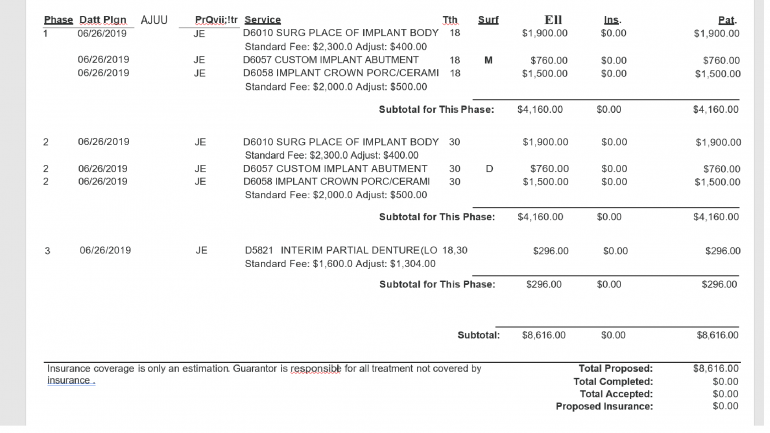
Dental Code D4381: Localized delivery of antimicrobial agents
Dental Code D4381 refers to the localized delivery of antimicrobial agents via a controlled release vehicle into diseased crevicular tissue, per tooth. This specialized dental procedure is commonly employed in the field of dentistry to treat and manage specific oral conditions, such as periodontal disease, that require targeted antimicrobial therapy.
Dental Code D4381: Price Ranges & Savings
As with other services, prices in America vary from dentist to dentist and city to city. The minimum charge for this service is $40 and the maximum $200. Most dentists charge around $100.
Low cost of living | Medium cost of living | High cost of living |
Memphis (Tennessee), Cincinnati (Ohio) | Miami (Florida), Denver (Colorado), Austin (Texas) | (New York (New York), San Francisco (California) |
$40 | $100 | $200 |
What does Dental Code D4381 mean? Detailed Information and Steps of the Procedure
Dental Code D4381 signifies the administration of antimicrobial agents directly into diseased crevicular tissue surrounding a tooth. This procedure is particularly useful for managing periodontal disease, a chronic inflammatory condition that affects the supporting structures of the teeth, including the gums, periodontal ligament, and alveolar bone. By utilizing a controlled release vehicle, which gradually releases the antimicrobial agent over time, the procedure aims to effectively combat and control the progression of periodontal disease, promoting the healing of the affected tissues and reducing infection.
Examination and Diagnosis
The first step in the procedure involves a comprehensive examination and diagnosis by a dental professional experienced in periodontal therapy. During this stage, the dentist will perform a thorough evaluation of the patient's oral health, focusing on the presence of periodontal disease and determining the extent of tissue involvement. The dentist will assess the need for localized antimicrobial treatment and develop an individualized treatment plan based on the patient's specific condition.
Preparation and Isolation
Once the diagnosis is complete, the dental professional will prepare the patient for the procedure. This typically involves isolating the tooth or teeth requiring treatment to create a clean and controlled environment. Isolation is typically achieved using a dental dam, a thin sheet of rubber that is placed over the teeth and gums surrounding the treatment area. The dental dam helps to keep the treatment site dry and free from contamination by saliva or other oral fluids during the procedure.
Scaling and Root Planing
Before the localized delivery of antimicrobial agents, the dental professional may perform scaling and root planing (SRP). This crucial step involves the thorough removal of plaque, tartar, and bacterial deposits from the tooth's surface and root below the gumline. Scaling is performed using specialized dental instruments to scrape away the accumulated deposits, while root planing smooths the root surfaces, making it more difficult for bacteria to adhere and allowing the gum tissues to reattach more effectively. SRP is essential as it eliminates the source of infection, reduces inflammation, and enhances the efficacy of the subsequent antimicrobial therapy.
Controlled Release Vehicle Placement
Once the tooth is adequately prepared, the dental professional proceeds with the placement of the controlled release vehicle into the diseased crevicular tissue. The controlled release vehicle is typically a biocompatible material, such as a gel or chip, that contains the antimicrobial agent. It is carefully positioned within the periodontal pocket, ensuring maximum contact with the affected tissue. The controlled release vehicle acts as a carrier for the antimicrobial agent, gradually releasing it over time to provide sustained therapeutic effects within the targeted area. This controlled release mechanism ensures that the antimicrobial agent remains present in the pocket, continuously combating the bacterial infection and promoting healing.
Post-Treatment Care and Follow-Up
Following the placement of the controlled release vehicle, the dental professional will provide detailed instructions for post-treatment care. This may include recommendations for proper oral hygiene practices, such as brushing techniques, flossing, and rinsing with prescribed antimicrobial mouthwashes. It is crucial for patients to maintain good oral hygiene practices to prevent the recurrence of periodontal disease and promote optimal healing. The dental professional will schedule regular follow-up appointments to monitor the patient's progress, assess the treatment's effectiveness, and make any necessary adjustments to the treatment plan.
Summary of Dental Code D4381
Dental Code D4381 involves the localized delivery of antimicrobial agents into diseased crevicular tissue to effectively treat conditions like periodontal disease. The procedure encompasses several steps, including examination and diagnosis, preparation and isolation, scaling and root planing, controlled release vehicle placement, and post-treatment care. By directly targeting the affected area, this procedure aids in managing oral infections, reducing inflammation, and promoting improved oral health.
It is important to note that Dental Code D4381 should be performed by qualified dental professionals who have the necessary expertise and training in periodontal therapy. If you have concerns about periodontal disease or require treatment, it is advisable to consult with your dentist or periodontist for a personalized evaluation and appropriate recommendations tailored to your specific needs. By promptly addressing periodontal disease through targeted antimicrobial therapy, you can enhance your oral health and maintain a healthy smile.
Embrace a brighter future with
Dr. BestPrice! Compare costs, make informed decisions, and invest in your oral health without the financial strain.